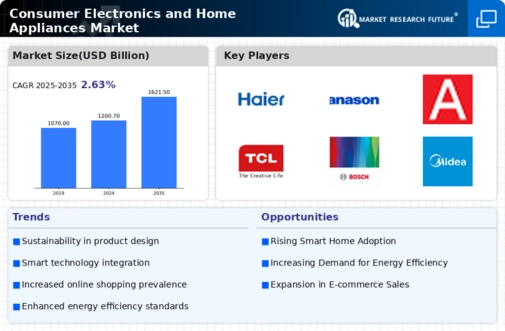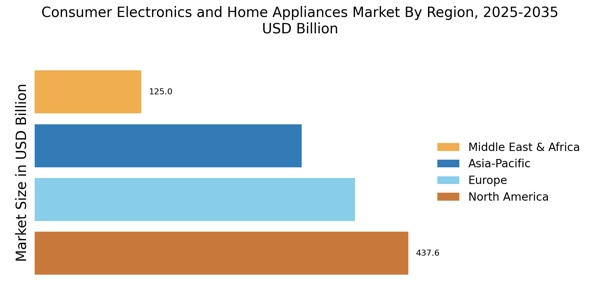E-commerce Growth
The rise of e-commerce has significantly impacted the Consumer Electronics and Home Appliances Market. With more consumers opting to shop online, the convenience and accessibility of purchasing electronics and appliances have increased. Data suggests that online sales in this sector have surged, with e-commerce platforms accounting for a substantial portion of total sales. This shift not only allows consumers to compare products easily but also provides access to a wider range of options. Retailers are adapting by enhancing their online presence and offering exclusive online deals, which is likely to further stimulate growth in the Consumer Electronics and Home Appliances Market.
Increased Consumer Demand
Consumer preferences are evolving, leading to increased demand for advanced consumer electronics and home appliances. The Consumer Electronics and Home Appliances Market is witnessing a shift towards products that offer enhanced functionality and energy efficiency. Recent surveys indicate that over 60% of consumers prioritize energy-efficient appliances, reflecting a growing awareness of sustainability. This heightened demand is further fueled by the rise of remote work and home entertainment, as consumers seek to enhance their living environments. As a result, manufacturers are focusing on developing innovative products that cater to these changing preferences, thereby driving growth in the Consumer Electronics and Home Appliances Market.
Sustainability Initiatives
Sustainability initiatives are becoming a central theme in the Consumer Electronics and Home Appliances Market. As environmental concerns rise, consumers are increasingly seeking products that are eco-friendly and energy-efficient. Manufacturers are responding by developing appliances that minimize energy consumption and utilize sustainable materials. Recent statistics show that energy-efficient appliances can reduce energy usage by up to 30%, appealing to environmentally conscious consumers. This shift towards sustainability not only meets consumer demand but also aligns with regulatory pressures for greener products, thereby driving growth in the Consumer Electronics and Home Appliances Market.
Technological Advancements
The Consumer Electronics and Home Appliances Market is currently experiencing rapid technological advancements that are reshaping product offerings. Innovations such as artificial intelligence, machine learning, and the Internet of Things are becoming increasingly integrated into consumer electronics and home appliances. For instance, smart refrigerators now offer features like inventory management and recipe suggestions, enhancing user convenience. According to recent data, the market for smart home devices is projected to grow at a compound annual growth rate of over 25% in the coming years. This trend indicates a strong consumer preference for technologically advanced products, which is likely to drive growth in the Consumer Electronics and Home Appliances Market.
Focus on Health and Wellness
The Consumer Electronics and Home Appliances Market is increasingly aligning with the growing focus on health and wellness. Consumers are becoming more health-conscious, leading to a demand for appliances that promote healthier lifestyles. Products such as air purifiers, water filtration systems, and smart kitchen appliances that facilitate healthy cooking are gaining traction. Industry expert's indicates that the health and wellness segment is expected to grow significantly, as consumers prioritize products that contribute to their well-being. This trend is likely to drive innovation and product development within the Consumer Electronics and Home Appliances Market.


















Leave a Comment